26 August 2016
At the risk of sounding like a chocolate snob, I must insist that chocolate is NOT just chocolate. It’s like saying to a fashionista that clothes are just clothes, or to a wine connoisseur that wine is just wine…..
To elaborate, let me take you back in time – to the start of my Belgian chocolates tour. We are standing around the tantalising display of chocolates at Leonidas, in the Galeries Royales St Hubert. Our guide, Wanda, holds out a tray of bite-sized white chocolates. We take a piece each and sink our teeth into it, after which Wanda asks “Do you know what this is called?” Some stay silent, looking puzzled. “White chocolate”, I respond. “Yes, it’s covered in white chocolate, but what’s inside?” she replies. “This is called butter cream”, she eventually answers her own question.
Butter Cream
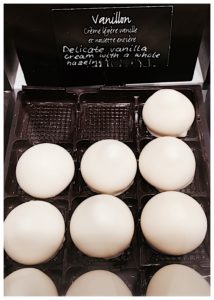 What is butter cream? As the name suggests, it’s chocolate containing a filling of butter and fresh cream, as well as milk and sugar. The ingredients are heated and mixed, then cooled and piped into moulded chocolate. Alternatively, the mixture is hardened through refrigeration, cut into shapes or shaped into balls, then enrobed in chocolate.
What is butter cream? As the name suggests, it’s chocolate containing a filling of butter and fresh cream, as well as milk and sugar. The ingredients are heated and mixed, then cooled and piped into moulded chocolate. Alternatively, the mixture is hardened through refrigeration, cut into shapes or shaped into balls, then enrobed in chocolate.
Truffle
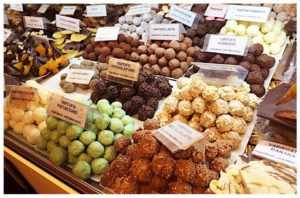
Next, she points to the round balls of chocolate, dusted in powder. “Truffles”, answers one of the chocolate enthusiasts in the group. Wanda nods her head. This type of chocolate derives its name from the expensive, rare and highly sought after fungal delicacy.
The truffle is typically circular or spherical, and comprised of a chocolate ganache that is coated in cocoa powder, nuts or a combination of the two. The truffle may also be a ganache filled into a round chocolate shell, which is then dusted in cocoa powder, nuts or a combination of both. Sometimes, the truffle may be liquid-filled, for example the champagne and liquor truffle.
Ganache
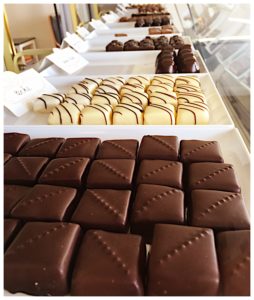
The ganache has French origins. “The difference between the ganache and the butter cream is the addition of chocolate to the filling”, according to Wanda.
To make a ganache, heated cream is added to chocolate and stirred, after which butter, sugar and other ingredients are mixed in to create the final flavoured ganache. The ganache may be piped into moulded chocolate or hardened and cut into shapes, then enrobed in chocolate.
Praline
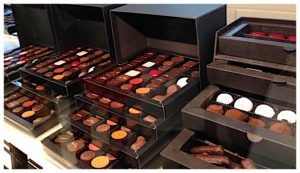 “Crunchy pralines are my favourite”, I tell Wanda. She explains that the traditional praline comprises almonds, usually crushed, coated with caramelised sugar and enrobed in chocolate. Crushed hazelnuts may sometimes be added.
“Crunchy pralines are my favourite”, I tell Wanda. She explains that the traditional praline comprises almonds, usually crushed, coated with caramelised sugar and enrobed in chocolate. Crushed hazelnuts may sometimes be added.
However, and confusingly, a praline can also be used as the generic term for any bite-sized filled chocolate. I prefer to stick to its traditional meaning.
Gianduja or Gianduia
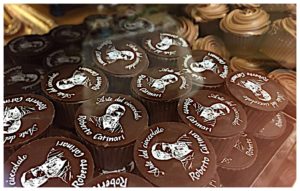 This chocolate originates from the Piedmont region of Italy, the home of Italian hazelnuts. As you’ve probably guessed, the gianduja is hazelnut-containing chocolate.
This chocolate originates from the Piedmont region of Italy, the home of Italian hazelnuts. As you’ve probably guessed, the gianduja is hazelnut-containing chocolate.
Hazelnuts are ground to a paste and piped into moulded chocolate. Alternatively, the hazelnut paste may be mixed into chocolate which is then set in moulds, or piped into swirls and set.
Rocher
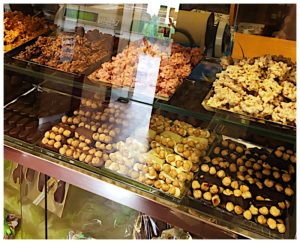 Rocher means rock, in French. In chocolate terms, it refers to slivers or whole pieces of nuts, usually almonds, coated in caramelised sugar, then dipped in chocolate and shaped into small rocks.
Rocher means rock, in French. In chocolate terms, it refers to slivers or whole pieces of nuts, usually almonds, coated in caramelised sugar, then dipped in chocolate and shaped into small rocks.
Mendiant
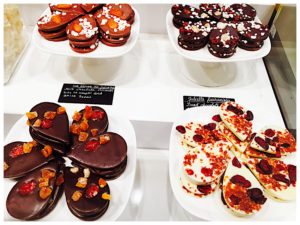 The mendiant has its historical origins in France. It’s the word for “beggar” in French and was originally created to represent the mendicant or religious figures who rely solely on the charity of others to survive.
The mendiant has its historical origins in France. It’s the word for “beggar” in French and was originally created to represent the mendicant or religious figures who rely solely on the charity of others to survive.
As a chocolate, the mendiant is a thin disc, studded with nuts and dried fruit. While available throughout the year, it’s typically enjoyed during the festive Christmas period.
Marzipan
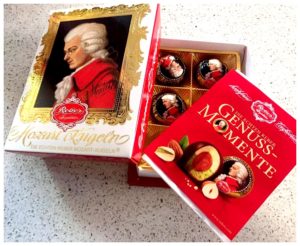
The traditional marzipan is a paste made of sugar, almond meal, and occasionally honey and almond extract. The paste is cut or shaped into bite-sized pieces and enrobed in chocolate.
The mozartkugel, of Austrian (and contentious German) origin, is a variant of this. Named after the famous musician, Wolfgang Amadeus Mozart, it’s pistachio marzipan with nougat, covered in dark chocolate.
Bar or Tablet
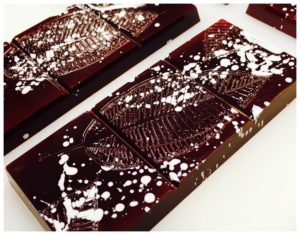 Perhaps the most ubiquitous and widely known of all chocolates, the bar or tablet is simply chocolate, set in a rectangular or square mould. The chocolate may be flavoured, ingredients like dried fruit and nuts may be added or it may be filled.
Perhaps the most ubiquitous and widely known of all chocolates, the bar or tablet is simply chocolate, set in a rectangular or square mould. The chocolate may be flavoured, ingredients like dried fruit and nuts may be added or it may be filled.
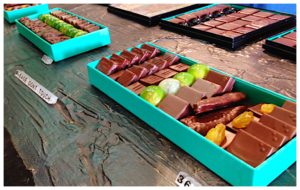 At the conclusion of the tour, we are grouped around the display of Patrick Roger’s masterful creations. Wanda points to different varieties of chocolates and asks us to name them, as a test of our knowledge. Suffice to say, we all pass with flying colours.
At the conclusion of the tour, we are grouped around the display of Patrick Roger’s masterful creations. Wanda points to different varieties of chocolates and asks us to name them, as a test of our knowledge. Suffice to say, we all pass with flying colours.
There’s a lot to be learnt and appreciated about chocolates. Whilst I don’t expect us all to be experts or enthusiasts, I do ask you to spare a thought for the history, skills, artistry and creativity that have gone into the creation of each chocolate variant.
Therefore, when you take your next bite of chocolate, please give it the recognition that it deserves and call it by its name!